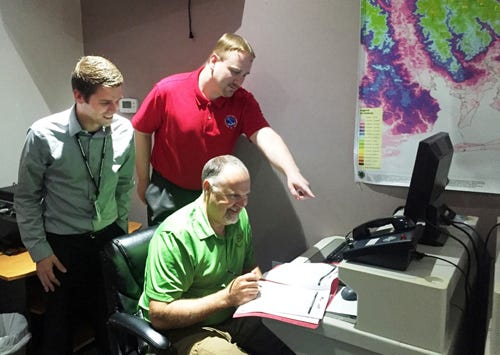
CRESTVIEW — The chances of a tsunami hitting Destin or Fort Walton Beach are slim, but the potential exists.
And if it does, a Crestview High School and Northwest Florida State College alumnus wants his native Okaloosa County to be ready.
See video of Sparagowski discussing the Gulf Coast's tsunami risk>>
See part 2 of Sparagowski discussing the Gulf Coast's tsunami risk>>
In 2015, Chayne Sparagowski, now an emergency management specialist in Corpus Christi, Texas, was appointed the Gulf Coast’s coordinator of tsunami preparedness for the National Weather Service’s National Tsunami Hazard Mitigation Program.
Wednesday Sparagowski was back in the area, certifying Santa Rosa County as not just Florida’s first tsunami-ready Gulf Coast county, but the first in the entire five-state Gulf of Mexico region.
Sparagowski said several Atlantic coast Florida counties are also certified.
OKALOOSA, ESCAMBIA NEXT?
Okaloosa and Escambia Counties are currently considering certification, a process that took Santa Rosa about a year, Sparagowski said.
“Basically, there’s a set of requirements that they have to work towards, which include several components,” he said.
Per federal requirements, a county must have the ability to receive a tsunami warning, procedures to notify the public, and conduct public education and readiness exercises.
One of Santa Rosa’s the biggest hurdles, Sparagowski said, was convincing the Board of Commissioners to fund beachside informational signage.
“It is not an easy feat in a place where tsunamis are not usually heard of,” he said.
COMPUTER MODELING
Currently Texas A&M University in Galveston is preparing high-resolution tsunami inundation computer models to help Okaloosa and Escambia prepare for certification.
The results probably won’t be ready until the end of 2016 because of the complexity of programming multiple scenarios, Sparagowski said.
But already preliminary modeling is showing a higher risk than previously thought, he said.
“The risk is there,” he said. “The probability is low but it’s a very high-consequence hazard. Originally along the Gulf Coast, before the high resolution models, we were thinking in terms inches and it was something we wouldn’t have to worry about, but as we started researching we saw it was feet. The maximum possibility is 15 to 20 feet.”
LAND-SLIDE DRIVEN
The closest geological fault lies in the south Caribbean Sea. It generated an early 20th-century tsunami off the coast of Puerto Rico that struck Texas.
But a Gulf Coast tsunami would more likely be caused by underwater land slides, Sparagowski said.
“It’s not going to be an earthquake-driven event,” he said.
Unlike storm surges, tsunamis strike quickly and with more strength, Sparagowski said.
“Generally speaking, along the Gulf Coast, you’re not going to see any inundation very far inland. It’ll be along the immediate coast and the barrier islands,” he said.
“Most of Destin would probably be OK. Okaloosa Island would probably have inundation in the areas along (U.S. Highway) 98 that normally flood in a storm surge.”
Sparagowski emphasized the “probably.”
“Because there’s been no actual modeling done in this area, we won’t know for sure yet,” he said.
—
BE TSUNAMI AWARE
A tsunami, a tidal wave generated by offshore seismic activity such as an underwater earthquake or land slide, often gives advance warning. According to National Weather Service advisories, if on the coast and you:
●See the water withdraw an unusual distance out to sea, run to high ground or inland
●Hear a strange roar, run to high ground or inland
Source: Santa Rosa County Emergency Management
A tsunami, a tidal wave generated by offshore seismic activity such as an underwater earthquake or land slide, often gives advance warning. According to National Weather Service advisories, if on the coast and you:
●See the water withdraw an unusual distance out to sea, run to high ground or inland
●Hear a strange roar, run to high ground or inland
Source: Santa Rosa County Emergency Management
BE TSUNAMI AWARE


This article originally appeared on Crestview News Bulletin: Crestview High, NWFSC alumnus preparing Gulf for tidal waves (VIDEOS)
